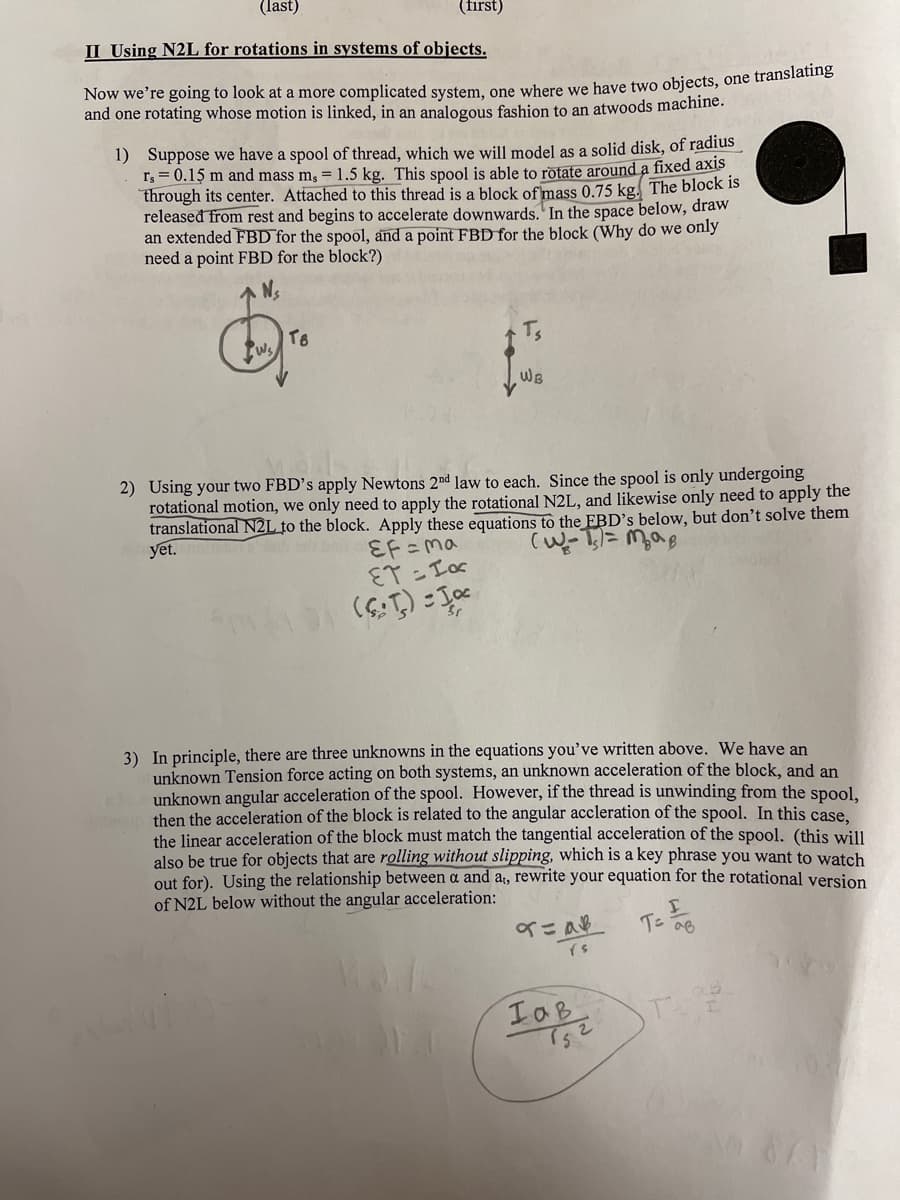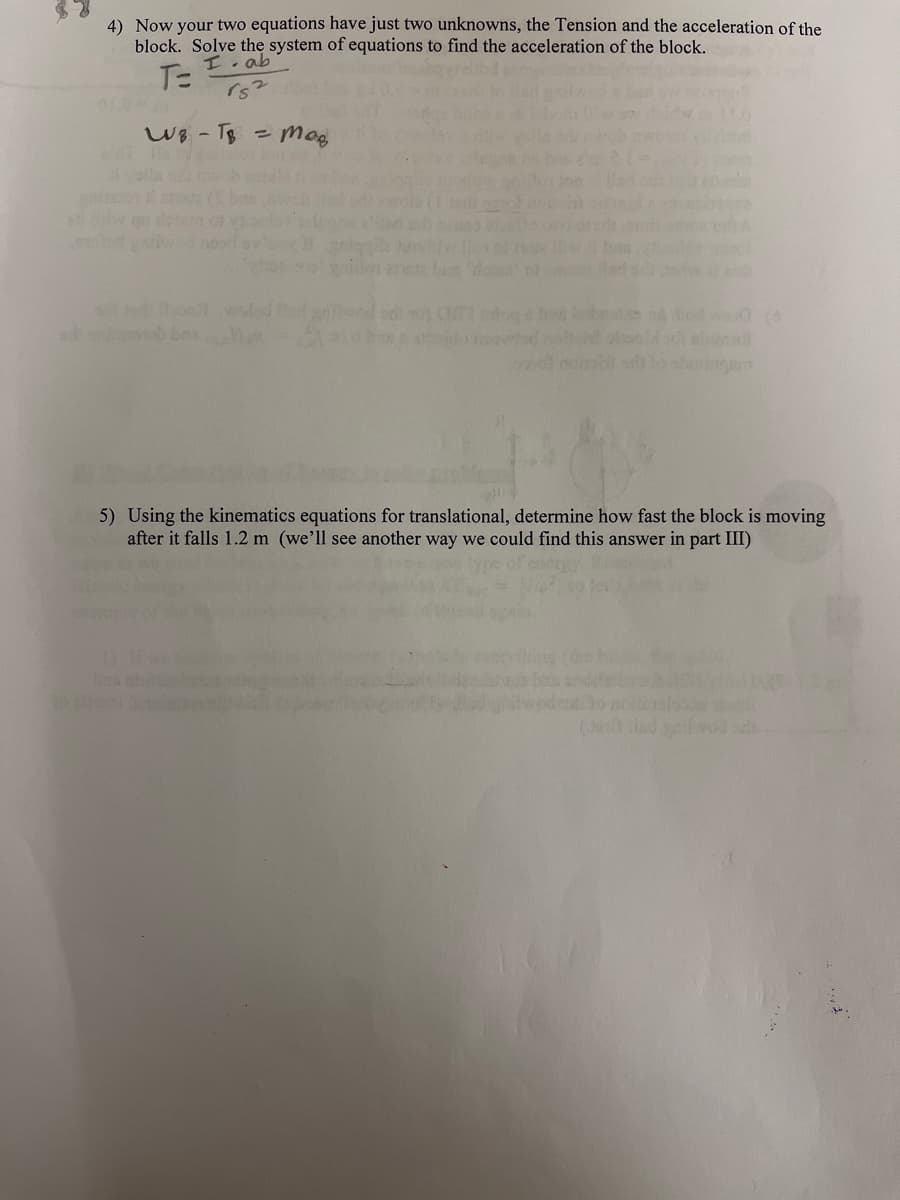4) Now your two equations have just two unknowns, the Tension and the acceleration of the block. Solve the system of equations to find the acceleration of the block. エ.ab WB - TB = Mog illen
4) Now your two equations have just two unknowns, the Tension and the acceleration of the block. Solve the system of equations to find the acceleration of the block. エ.ab WB - TB = Mog illen
University Physics Volume 1
18th Edition
ISBN:9781938168277
Author:William Moebs, Samuel J. Ling, Jeff Sanny
Publisher:William Moebs, Samuel J. Ling, Jeff Sanny
Chapter11: Angular Momentum
Section: Chapter Questions
Problem 67P: In 2015, in Warsaw, Poland, Olivia Oliver of Nova Scotia broke the world record for being the...
Related questions
Question
100%
I finished 1-3 but I need help with 4&5 and once I get those I’ll be able to send 6-8 for help!

Transcribed Image Text:(last)
(first)
II Using N2L for rotations in systems of objects.
Now we're going to look at a more complicated system, one where we have two objects, one translatng
and one rotating whose motion is linked, in an analogous fashion to an atwoods machine.
1) Suppose we have a spool of thread, which we will model as a solid disk, of radius
r; = 0.15 m and mass m, = 1.5 kg. This spool is able to rotate around a fixed axis
through its center. Attached to this thread is a block of mass 0.75 kg. The block is
released from rest and begins to accelerate downwards.' In the space below, draw
an extended FBD for the spool, and a point FBD for the block (Why do we only
need a point FBD for the block?)
Ts
Ws
WB
2) Using your two FBD's apply Newtons 2nd law to each. Since the spool is only undergoing
rotational motion, we only need to apply the rotational N2L, and likewise only need to apply the
translational N2L to the block. Apply these equations to the FBD’s below, but don't solve them
yet.
EF =ma
ET - Tor
3) In principle, there are three unknowns in the equations you've written above. We have an
unknown Tension force acting on both systems, an unknown acceleration of the block, and an
unknown angular acceleration of the spool. However, if the thread is unwinding from the spool.
then the acceleration of the block is related to the angular accleration of the spool. In this case.
the linear acceleration of the block must match the tangential acceleration of the spool. (this will
also be true for objects that are rolling without slipping, which is a key phrase you want to watch
out for). Using the relationship between a and a;, rewrite your equation for the rotational version
of N2L below without the angular acceleration:
イニ a
Tン
IaB
T

Transcribed Image Text:4) Now your two equations have just two unknowns, the Tension and the acceleration of the
block. Solve the system of equations to find the acceleration of the block.
I. ab
T=
WB - TB = Mog
am m be
5) Using the kinematics equations for translational, determine how fast the block is moving
after it falls 1.2 m (we'll see another way we could find this answer in part III)
(e ad sifwod a
Expert Solution
This question has been solved!
Explore an expertly crafted, step-by-step solution for a thorough understanding of key concepts.
Step by step
Solved in 4 steps with 4 images

Knowledge Booster
Learn more about
Need a deep-dive on the concept behind this application? Look no further. Learn more about this topic, physics and related others by exploring similar questions and additional content below.Recommended textbooks for you

University Physics Volume 1
Physics
ISBN:
9781938168277
Author:
William Moebs, Samuel J. Ling, Jeff Sanny
Publisher:
OpenStax - Rice University

College Physics
Physics
ISBN:
9781305952300
Author:
Raymond A. Serway, Chris Vuille
Publisher:
Cengage Learning

Physics for Scientists and Engineers: Foundations…
Physics
ISBN:
9781133939146
Author:
Katz, Debora M.
Publisher:
Cengage Learning

University Physics Volume 1
Physics
ISBN:
9781938168277
Author:
William Moebs, Samuel J. Ling, Jeff Sanny
Publisher:
OpenStax - Rice University

College Physics
Physics
ISBN:
9781305952300
Author:
Raymond A. Serway, Chris Vuille
Publisher:
Cengage Learning

Physics for Scientists and Engineers: Foundations…
Physics
ISBN:
9781133939146
Author:
Katz, Debora M.
Publisher:
Cengage Learning

College Physics
Physics
ISBN:
9781285737027
Author:
Raymond A. Serway, Chris Vuille
Publisher:
Cengage Learning

Glencoe Physics: Principles and Problems, Student…
Physics
ISBN:
9780078807213
Author:
Paul W. Zitzewitz
Publisher:
Glencoe/McGraw-Hill

College Physics
Physics
ISBN:
9781938168000
Author:
Paul Peter Urone, Roger Hinrichs
Publisher:
OpenStax College